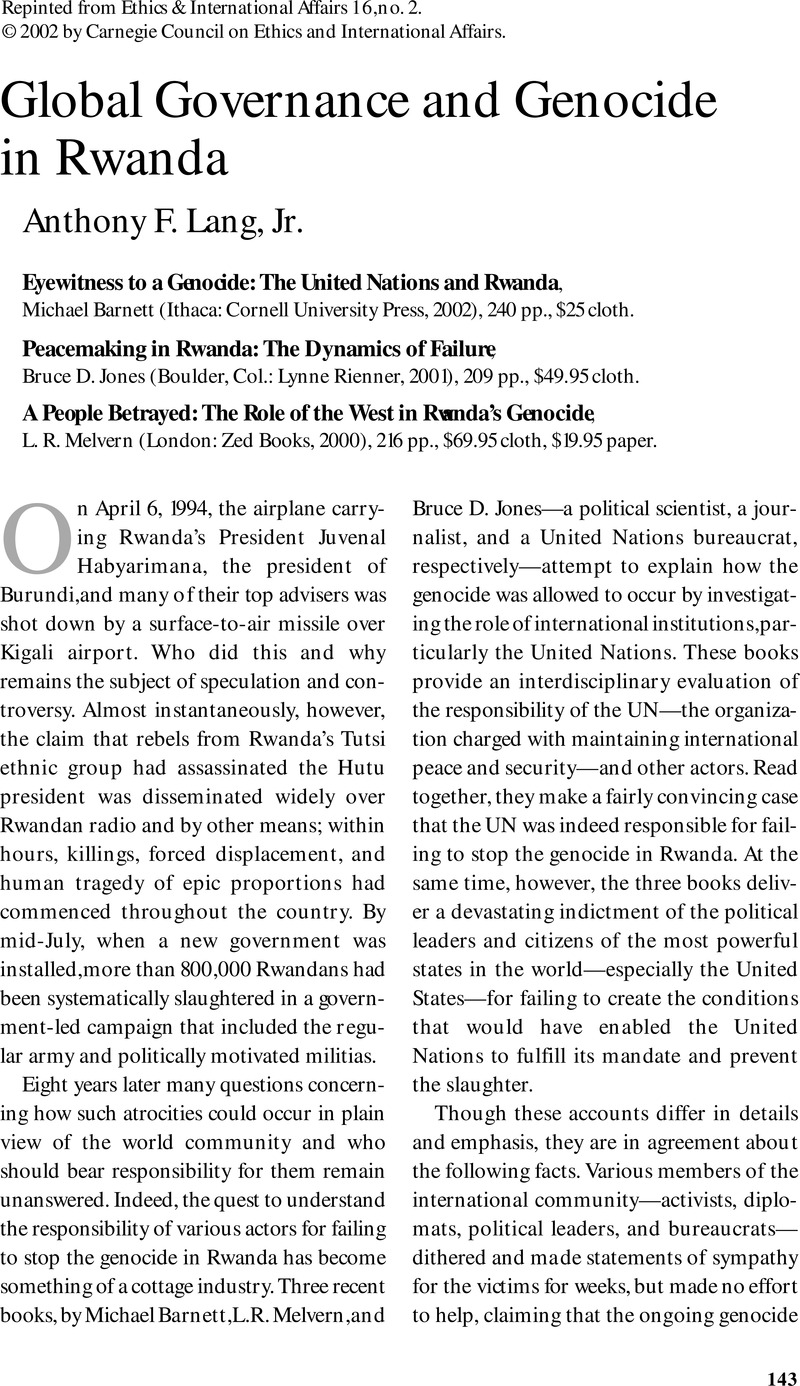No CrossRef data available.
Article contents
Global Governance and Genocide in Rwanda
Published online by Cambridge University Press: 28 September 2012
Abstract

- Type
- Review Essays
- Information
- Copyright
- Copyright © Carnegie Council for Ethics in International Affairs 2002
References
1 See Ronayne, Peter, Never Again? The United States and the Prevention and Punishment of Genocide Since the Holocaust (Lanham, Md.: Rowman & Littlefield, 2001), p. 174–75Google Scholar.
2 Alison Des Forges's Leave None to Tell the Story: Genocide in Rwanda(New York: Human Rights Watch, 1999) gives the most comprehensive account of the mechanics of the genocide. This detailed narrative on the events prior to and during the genocide is invaluable for those who wish to understand how so many could be killed in such a systematic and rapid fashion. The International Criminal Tribunal for Rwanda has also been central in identifying those individuals responsible for the killingsGoogle Scholar.
3 Samantha Power, A Problem from Hell: America and the Age of Genocide(New York: Basic Books, 2002) provides a stinging critique of the Clinton Administration's failure to act in Rwanda. On France's responsibility for the genocide, especially its support of the Rwandan government, see Monique Mas, Paris-Kigali, 1990–1994: lunettes coloniales, politique du sabre et onction humanitaire pour un génocide Afrique (Paris: l'Har-mattan, 1999). For an early condemnation of France's role see Francois-Xavier Verschave, Complicité de génocide: la politique de la France au Rwanda(Paris:Editions Découverte, 1994). See also the report of the French parliamentary inquiry, described in a special edition of Le Monde, “La France et le Rwanda,” December 17, 1998Google Scholar.
4 There exists one other ethnic group in Rwanda, the Twa, but they seemed to have played little part in the conflictGoogle Scholar.
5 See Boutros-Ghali, Boutros, Egypt's Road to Jerusalem: A Diplomat's Story of the Struggle for Peace in the Middle East (New York: Random House, 1997Google Scholar) for Boutros-Ghali's description of his role in the Egyptian Foreign Ministry.
6 For a reproduction of the telegram, see Adleman, Howard and Suhrke, Astri, eds., Path of a Genocide: The Rwandan Crisis from Uganda to Zaire (New Brunswick, N.J.: Transaction, 1999Google Scholar), pp. xxi-xxii.
7 See Boutros-Ghali, Boutros, Unvanquished: A U.S.-U.N. Saga (New York: Random House, 1999), p. 129–41Google Scholar; for the official UN assessment of the Rwandan genocide and its response, see “Report of the Independent Inquiry into the Actions of the United Nations during the 1994 Genocide in Rwanda” from December 15, 1999, available at http://www.un.org/ossg/rwanda_report.htm.




